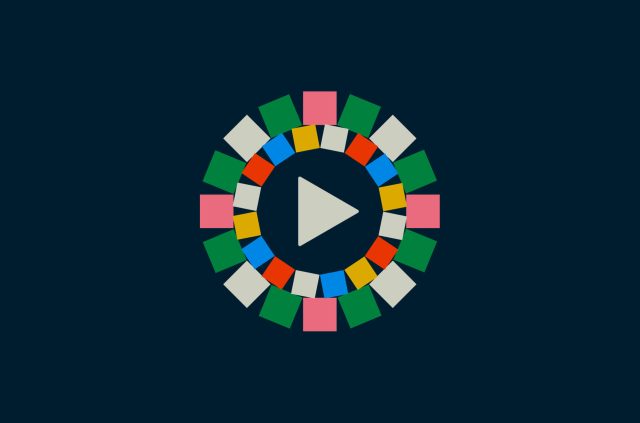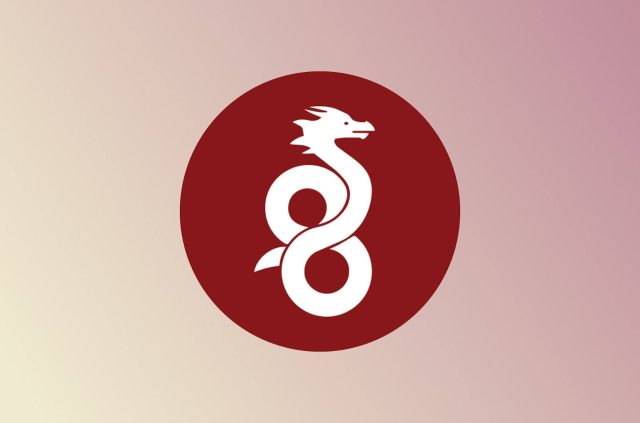The favorites to win this year’s FIFA Women’s World Cup


This article presents predictions for the 2023 Women's World Cup based on a survey conducted prior to the event. On August 20, 2023, Spain secured a 1-0 victory in the tournament, triumphing over England's Lionesses.
- The U.S., Brazil, and Germany are the top contenders to win the 2023 FIFA Women's World Cup, according to fan enthusiasm and data-driven forecasts.
- Brazil leads in excitement for the tournament, with 89% of respondents expressing interest, followed closely by the U.S. with 84%.
- Brazilian legend Marta Vieira da Silva stands out as the fan favorite, adding significance to her final appearance in the tournament.
- The 2023 Women's World Cup is reshaping the sport by increasing media coverage, resolving broadcasting rights issues, and showcasing the rising market value of women's soccer.
- The tournament is taking strides toward gender equality, with FIFA guaranteeing a minimum payment to all participants and increasing the prize money by 367%.
- Live stream the 2023 FIFA Women’s World Cup online for free with a VPN.
With just a few weeks to go until the final match kicks off on August 20, the 2023 FIFA Women's World Cup is captivating the world with unforgettable moments and fierce competition. This monumental tournament marks a powerful revolution in women's soccer, breaking barriers and redefining the sport's landscape.
In our exclusive market research, ExpressVPN delves into the passion, determination, and sheer talent that has entranced global audiences. We also explore fan excitement that focuses on the predicted winners, with the U.S. emerging as a firm contender for the coveted trophy.
Read on as we unpack our findings and explore this defining moment in women’s sports history that’s set to become a revolution, inspiring future generations of female athletes and reshaping soccer for years to come.
Jump to...
A rise in fan enthusiasm
The favorites to win
A soccer revolution
Brazil and the U.S. lead enthusiasm in the FIFA Women’s World Cup
The 9th edition of the FIFA Women's World Cup is in full swing, marking a historic moment as Australia and New Zealand co-host the event for the first time. Adding to the excitement, this year's tournament has expanded to include 32 teams (up from 24) and a record-breaking 64 games!
Increased fan interest
The interest and enthusiasm surrounding the Women's World Cup has soared to new heights, as highlighted by a recent survey conducted by ExpressVPN and sports marketing agency ONE8Y. More than 14,000 soccer enthusiasts from nine countries (Brazil, USA, New Zealand, Portugal, Germany, England, France, Spain, and Italy) participated in the survey, a testament to the growing passion for women’s soccer:
- Brazil leads the pack, with an impressive 89% of respondents expressing excitement for the sport.
- The U.S., four-time Women's World Cup champions, follows closely, with 84% of respondents showing interest.
- In the host country, New Zealand, a significant 83% of those surveyed expressed enthusiasm for the tournament.
National teams prevail
Not surprisingly, the survey also reveals a strong connection between soccer enthusiasts and their national teams. 65% of respondents identified themselves as fans of their respective national teams, surpassing the average of 57% who declared allegiance to women's soccer in general. This bond shows how much national teams mean to the people of their countries. It highlights the deep importance of these teams and how they can bring countries together through sports.
Battling stereotypes
Despite the rising interest and support, there are still lingering stereotypes surrounding women’s soccer. Some skeptics perceive men’s soccer as more dominant (19%) and believe that the women's game offers a lower quality of play (14%). Additionally, a few critics find the pace of women's soccer relatively slower and mundane (6%).
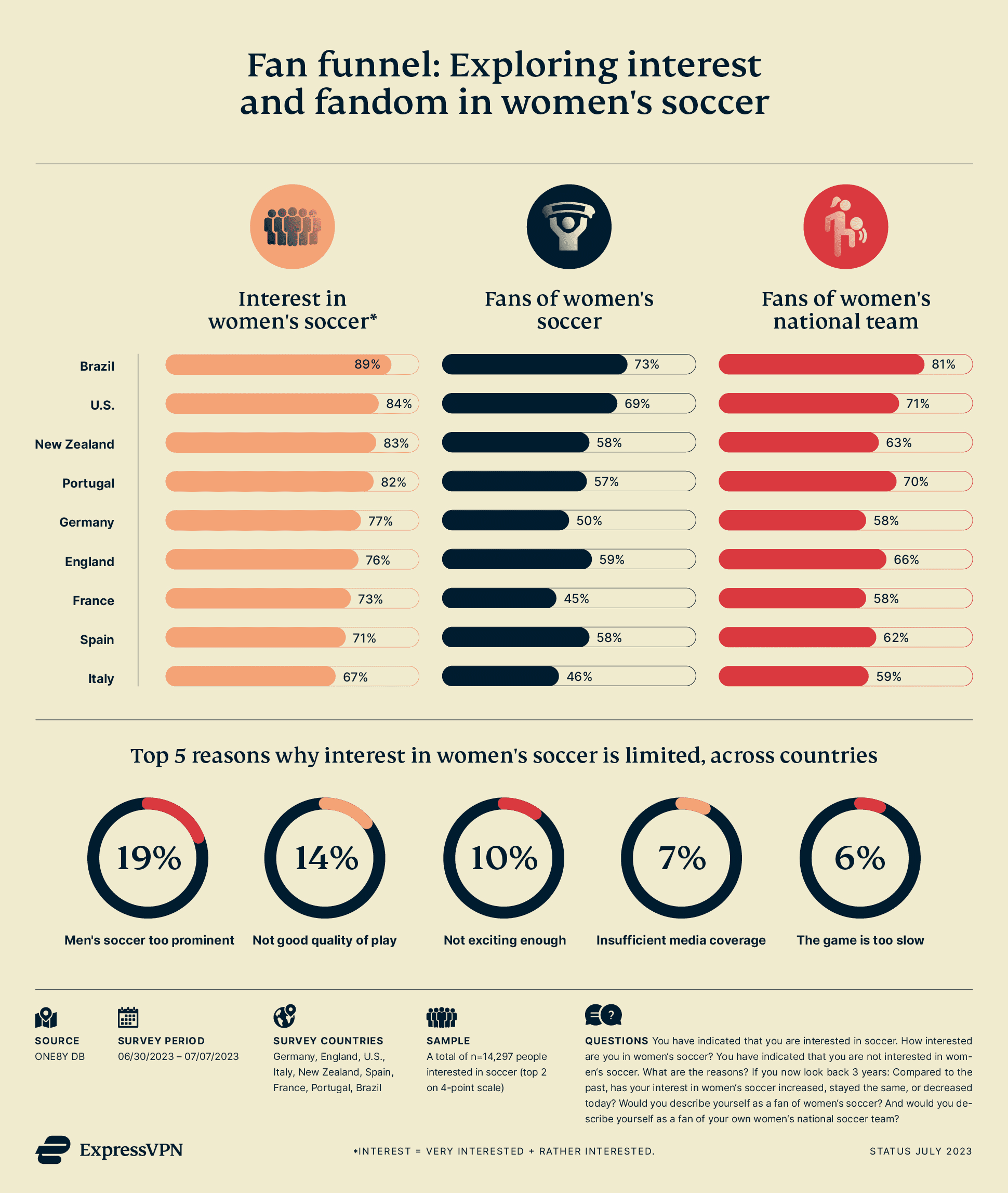
However, as the Women's World Cup unfolds on the global stage, it’s clear that these beliefs are unfounded. In fact, the women's game boasts a higher goal-scoring rate than its male counterpart, with an average of 3.32 goals per game compared with 2.50 goals per game in men's matches. It might be time for soccer fans to reject these long-held stereotypes about women's soccer.
Who are the favorites to win the 2023 FIFA Women's World Cup?
Amidst the heightened fan enthusiasm, it’s important to remember that the ultimate decider of the World Cup is the action on the pitch.
Team U.S. to take the crown?
Fans from around the globe have been eagerly following the matches in Australia and New Zealand since the tournament kicked off on July 20—and amidst the ongoing games, we gather their opinions on the favorites. According to the respondents' estimations, the four-time world champions, the U.S., have emerged as the top pick to win the tournament with 26% of the votes, followed by Brazil with 15%, and Germany with 10%. Meanwhile, Argentina and host country New Zealand are considered outsiders, both receiving 3% of the votes.
Marta Vieira da Silva is the fans' favorite player
Among the favorite players, legendary Brazilian soccer player Marta Vieira da Silva stands out. She is a six-time winner of the FIFA World Player of the Year award and is often regarded as the best player in the history of women's soccer. It’s likely that this World Cup will be her final appearance, making her presence in the tournament all the more significant.

Next, let's delve into a bit more data so we can try to predict the outcomes by exploring the “Favorites Matrix,” In this matrix, we group the countries that are taking part based on four different performance measures:
- All Stars: Very high chance of winning the title
- High Potentials: High chance of winning the title
- Underdogs: Low chance of winning the title
- Low Potentials: Almost no chance of winning the title
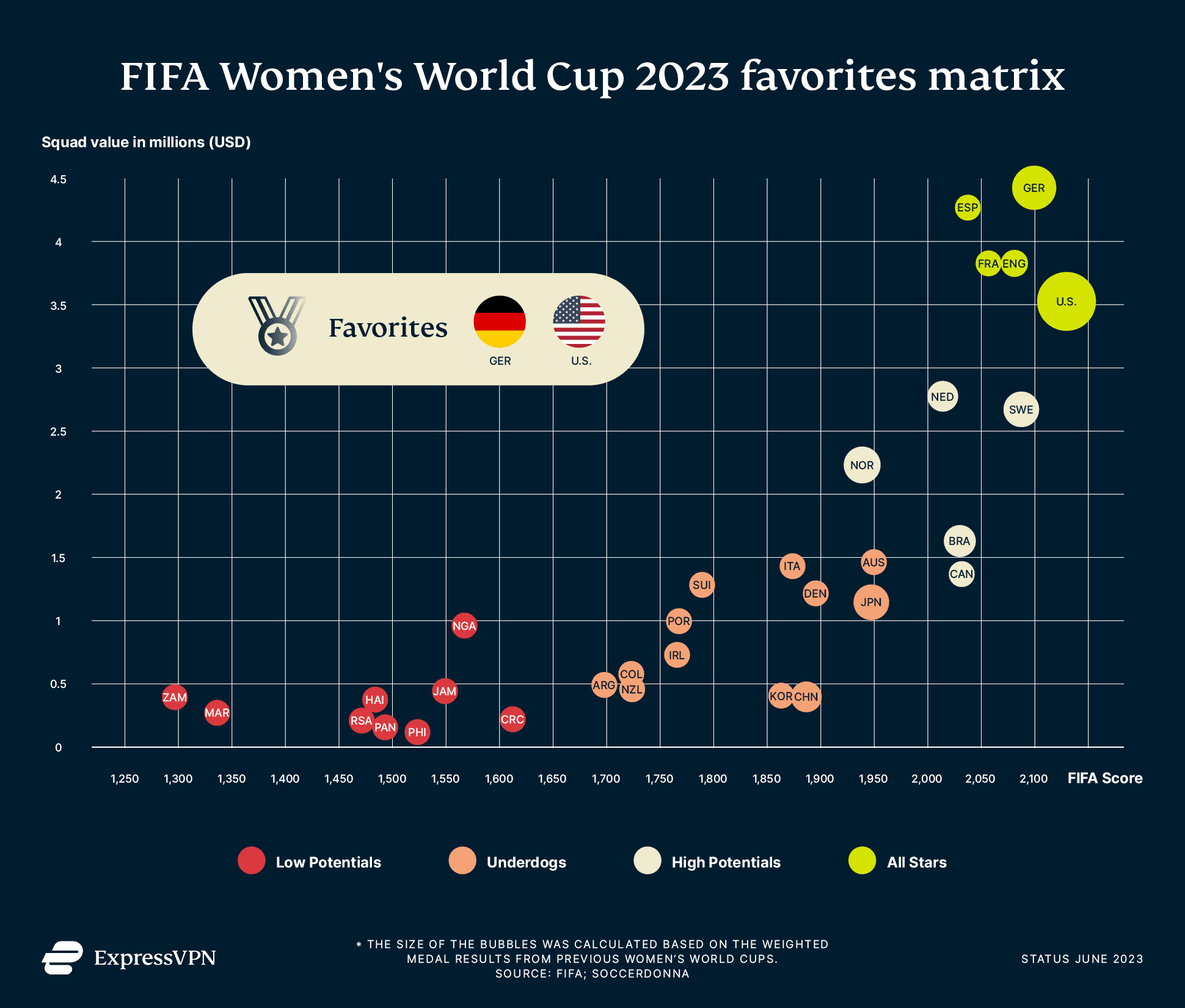
The clear favorites for the upcoming Women's World Cup are the U.S. and Germany. Both teams boast strong FIFA scores and a history of impressive performances in previous tournaments, making them formidable contenders for the title. The U.S., with its slightly higher FIFA Score and numerous historical World Cup victories, is undoubtedly a force to be reckoned with.
Interestingly, the countries predicted to have the lowest potential of winning, such as Zambia and Morocco, also have the least squad value. In contrast, countries with higher squad values, like France, Spain, and England, are also firm fan favorites.
Sweden stands out as the leading team in the “High Potentials” group, signifying a strong chance of a successful tournament. With an impressive FIFA Score and a history of achievements, Sweden is a team that shouldn’t be underestimated.
From the “Underdogs” category, Japan and host country Australia are best placed to upset the status quo with a surprise victory.
How the 2023 Women's World Cup is revolutionizing soccer
The 2023 Women's World Cup has proven to be more than just a celebration of talent and passion on the field. Beyond the matches and fan enthusiasm, this tournament is driving significant changes in the sport, addressing crucial aspects that are revolutionizing women's soccer worldwide.
From increased media coverage to the battle for broadcasting rights, the rising market value of women's soccer, and strides toward gender equality in pay, the 2023 Women's World Cup is leaving an indelible mark on the future of the sport.
Increased media coverage fuels interest and participation
This year’s Women's World Cup has witnessed an unprecedented surge in media coverage and fan interest, signaling a transformation in women's soccer. Attendance at women's club soccer matches has been staggering, with historic moments such as over 91,000 fans gathered at Camp Nou for the UEFA Women's Champions League semifinal match between FC Barcelona and VfL Wolfsburg. Similarly, a sold-out Emirates Stadium cheered on FC Arsenal during their match against VfL Wolfsburg.
Our market research findings have also solidified the growing allure of women's soccer, with nearly one-third of respondents having already attended a live match in a stadium. Notably, Spain and the U.S. lead the charge in live match attendance, boasting 44% and 40% of the respondents, respectively, while Germany closely follows with 37%.
Countries like the U.S. and New Zealand have also emerged as leaders in active player engagement, displaying three to four times more involvement than Portugal or Italy. This reflects deeper and more substantial participation of women in playing the sport in these nations, fostering a promising future for women's soccer.
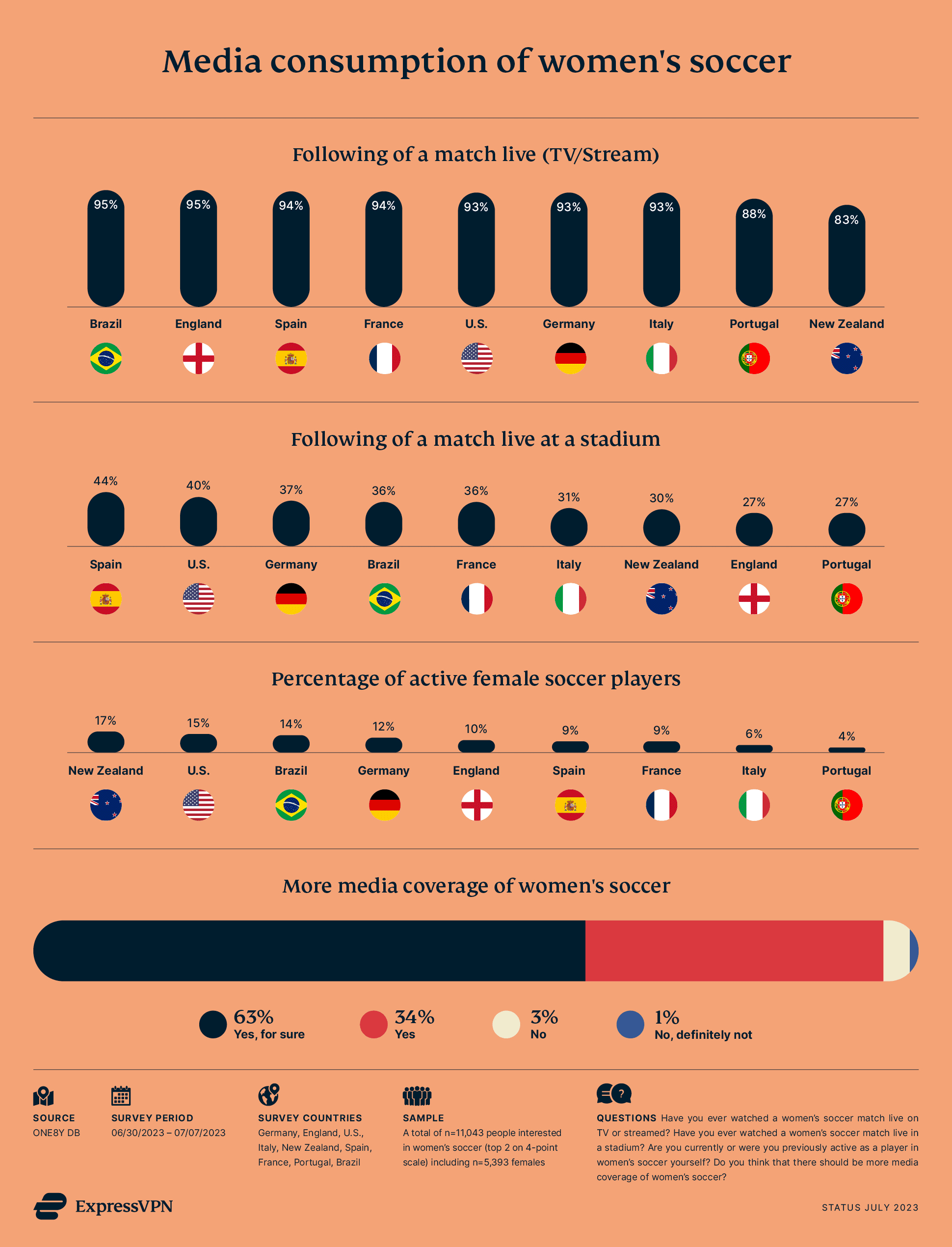
As the Women's World Cup continues to unfold, there is hope that the increased media coverage and support during the tournament will inspire even more women to actively participate in the sport. This growth in participation will likely fuel the progress and recognition of women's soccer on the global stage, transforming the landscape of the sport for years to come.
The battle for broadcasting rights: A pivotal turning point
The overwhelming fan interest in women's soccer has brought the issue of broadcasting rights to the forefront, becoming a pivotal turning point in the sport's revolution. Unlike previous editions, individual negotiations arose for the broadcasting rights of the Women's World Cup, leading to debates between FIFA and the “Big 5” European soccer nations (England, Spain, Germany, France, and Italy).
The stakes were high, with FIFA demanding nearly 10.9 million USD for the broadcasting rights—an amount the “Big 5” broadcasters were initially unwilling to pay. This demand was met with resistance, and broadcasters' offers were significantly lower, ranging from 20 to 100 times less than what FIFA sought. This standoff raised genuine concerns that Women's World Cup matches might not be broadcasted in crucial countries, potentially impeding the development of women's soccer in those regions.
However, a solution was found through the European Broadcasting Union (EBU), which allowed the “Big 5” European soccer nations to join an existing agreement negotiated between the EBU and FIFA for the 2019 Women's World Cup in France. This decision granted broadcasters the right to televise the Women's World Cup in their respective markets, avoiding the worst-case scenario and enabling women's soccer to continue its growth and progress in these important European nations.
The resolution of the broadcasting issue represents a critical milestone in the evolution of women's soccer. By securing broadcasting rights and expanding the sport's reach, women's soccer gains a platform to inspire a broader audience, further driving its progress and recognition on a global scale.
The rising market value is a testament to the potential of women’s soccer
The 2023 Women's World Cup has shone a spotlight on an increased market value of women's soccer, underscoring its immense potential for growth and development. Enthusiastic willingness among fans to invest in the tournament has showcased the significant interest and demand for women's soccer.
Our market research findings reveal that viewers are willing to spend an average of 26.12 USD to watch the matches on live TV or via streaming services, with U.S. fans willing to fork out 50.70 USD per viewer, to access all the games. Extrapolating these figures reveals the immense market value, with the estimated value of the U.S. reaching an impressive 1.3 billion USD, and Germany at 216 million USD despite an initial bid of only 5.45 million USD from broadcasters.
The rising market value not only elevates the Women's World Cup but also makes women's soccer an enticing proposition for advertisers and rights buyers worldwide. This newfound recognition and potential for revenue generation bodes well for the future of women's soccer, as it continues to gain momentum and expand its global footprint.

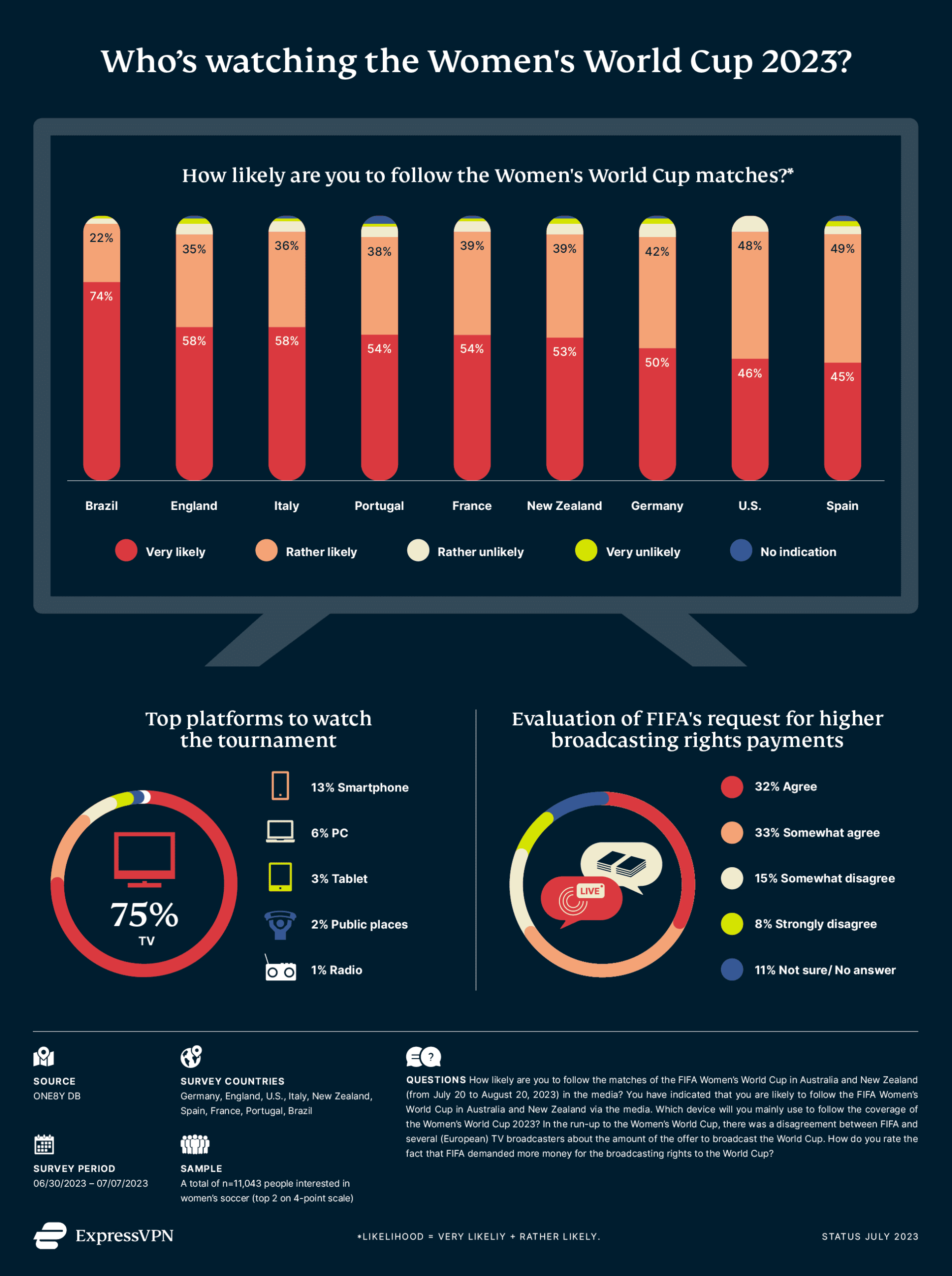
The gender pay gap: Paving the way for an inclusive future
As the Women's World Cup gains momentum, it emerges as a powerful platform for advocating gender equality in soccer's compensation landscape. The issue of prize money in Women's World Cups has long been a subject of scrutiny, revealing glaring disparities between the amounts awarded to men vs. women. In the past, women players received substantially lower prize money, with the 2018 Men's World Cup paying out 400 million USD, while the 2019 Women's World Cup received only 30 million USD.
In response to demands from the players' union “Fifpro,” FIFA has taken significant steps to address this inequality. In a historic move, all participants in the 2023 Women's World Cup will receive a guaranteed minimum of 30,000 USD. This decision is an essential stride towards greater gender equality in the sport at its highest level. Moreover, the total prize money for the tournament has been raised by 367%, amounting to 110 million USD, with approximately 49 million USD allocated to players. The winners of the tournament will receive 270,000 USD each.
While progress has been made in terms of prize money at the World Cup, the issue of annual salaries at the club level remains a challenge. Calls for equal pay or higher wages for women players continue to grow. However, significant disparities persist between male and female soccer players at the club level:
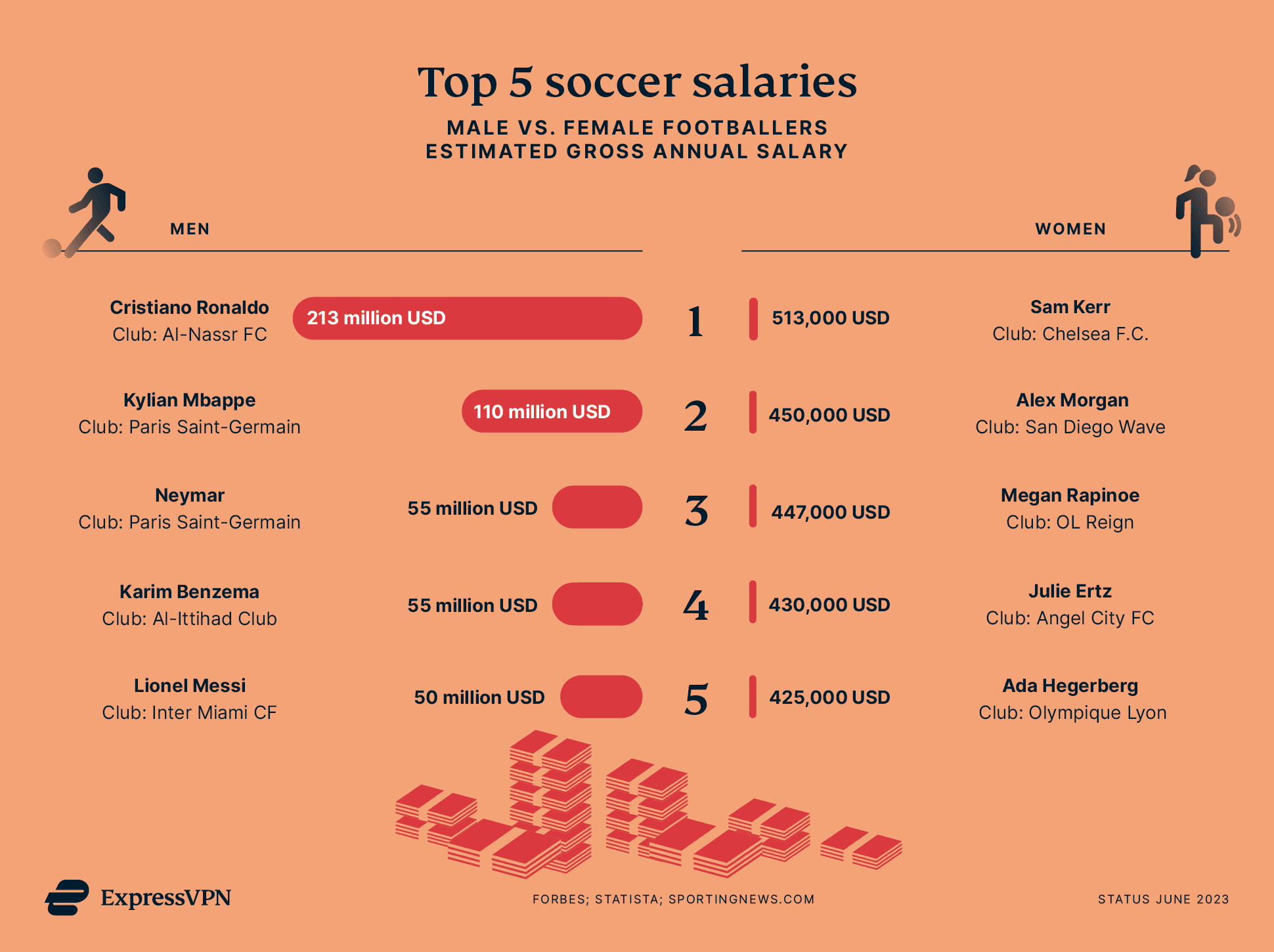
The push for equal pay receives overwhelming support among respondents interested in women's soccer, even with the knowledge that men's revenues currently exceed those of women. Combining all surveyed countries, 85% are in favor of equal pay, with only 12% against it (3% did not respond). Brazil stands out with an impressive 89% in support of equal pay among all nations, while England has the highest percentage of fans (19%) who are against equal pay for women and men in sports.
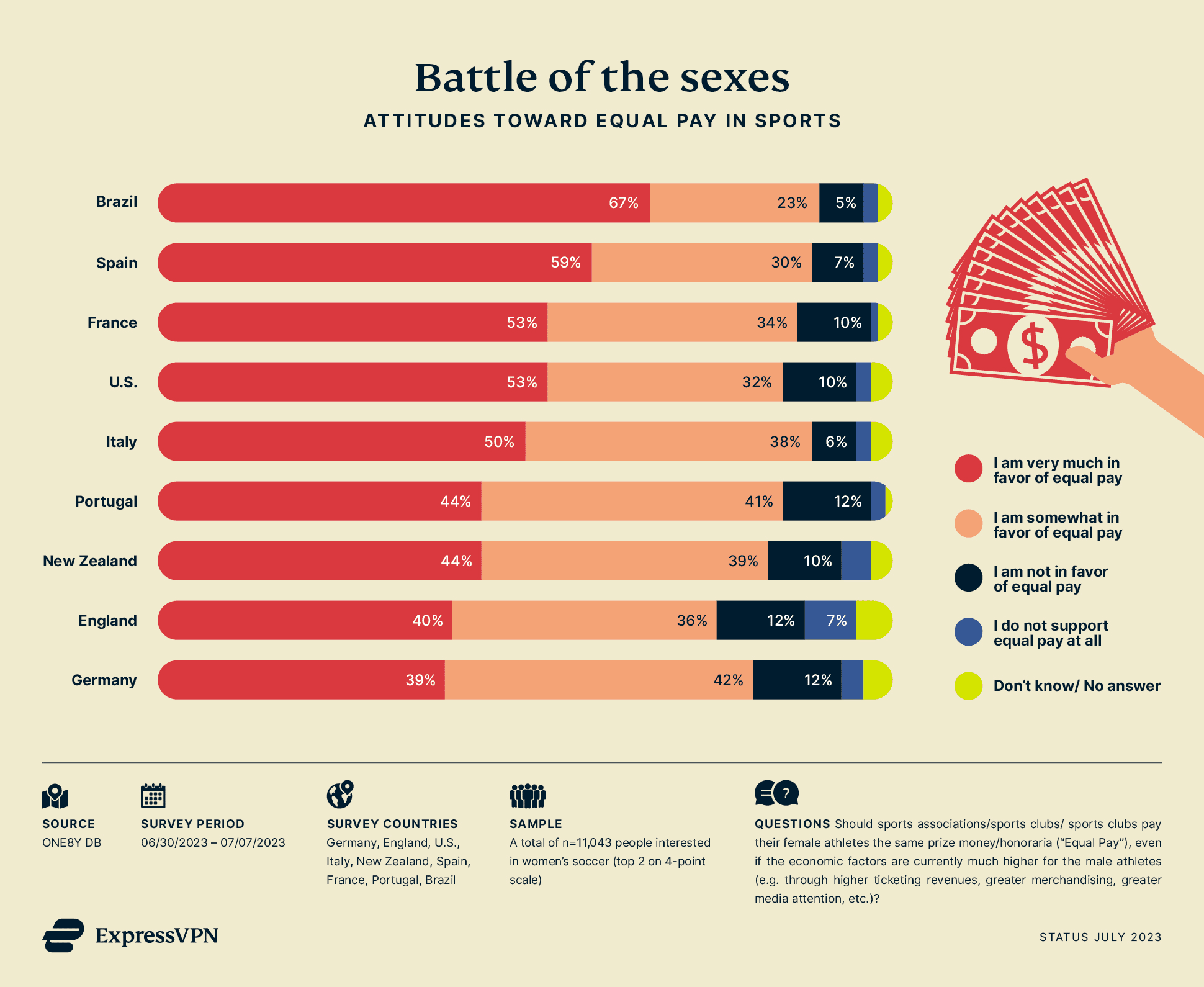
The Women's World Cup serves as a critical milestone in the ongoing journey toward gender equality in soccer. As the tournament inspires future generations of female players, it fosters positive discussions and initiatives that reshape the landscape of women's soccer, paving the way for a more inclusive and empowering future.
Make sure you don’t miss a second of the 2023 FIFA Women’s World Cup action. Safely and securely stream every match with a high-quality VPN, from ExpressVPN.
FAQ: FIFA Women's World Cup 2023
What teams have qualified for the FIFA Women’s World Cup 2023?
AFC: China, Japan, Philippines, South Korea, Vietnam
CAF: Morocco, Nigeria, South Africa, Zambia
CONCACAF: Canada, Costa Rica, Haiti, Jamaica, Panama, United States
CONMEBOL: Argentina, Brazil, Colombia
UEFA: Denmark, England, France, Germany, Italy, Netherlands, Norway, Portugal, Republic of Ireland, Spain, Sweden, Switzerland
How many matches will be played in the World Cup 2022?
Which country has won the FIFA Women’s World Cup the most?
Take the first step to protect yourself online. Try ExpressVPN risk-free.
Get ExpressVPN



